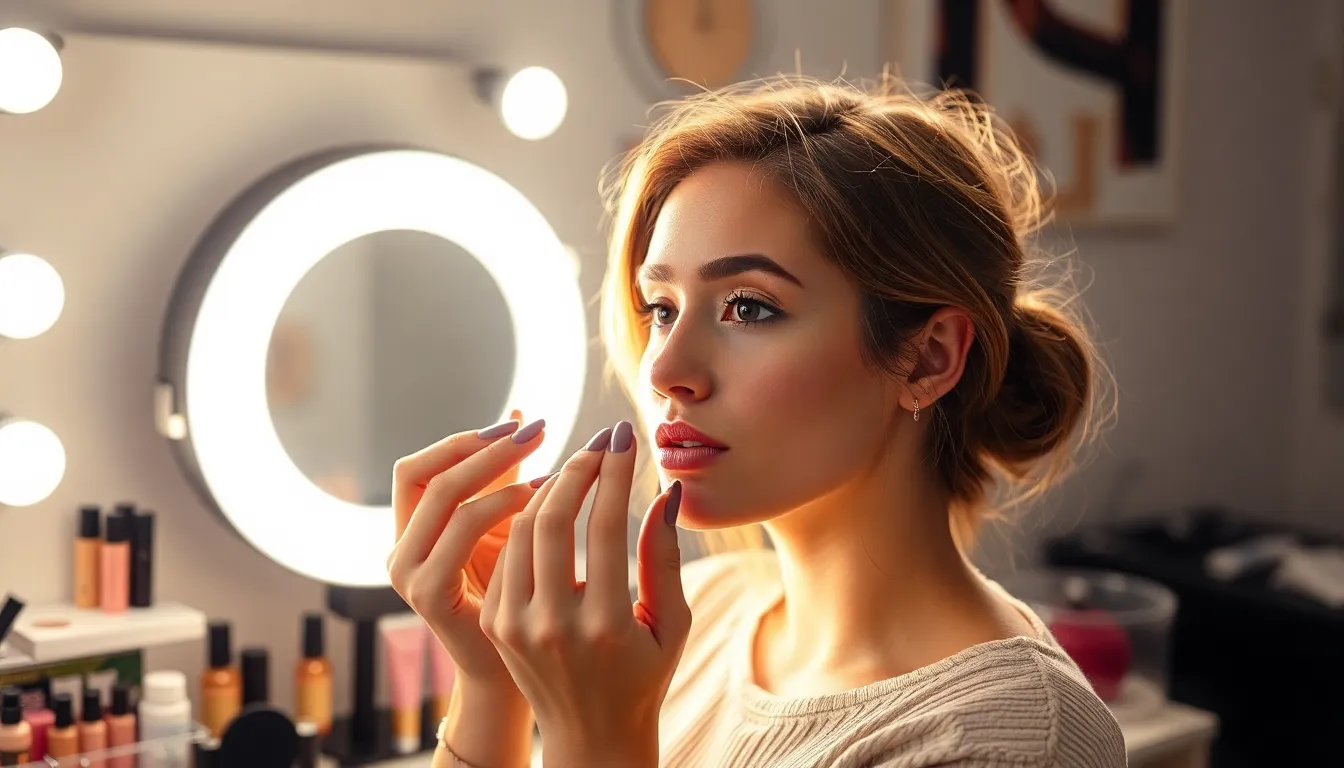When it comes to lighting up a scene, choosing between a ring light and a panel light can feel like picking a favorite child. Both have their merits, but which one truly deserves the spotlight? Picture this: a ring light surrounds your camera like a warm hug, creating that dreamy glow every influencer craves. Meanwhile, the panel light stands tall and proud, ready to illuminate an entire room with its versatile brilliance.
Table of Contents
ToggleOverview of Lighting Options
Ring lights and panel lights serve distinct purposes in the realm of photography and videography. Ring lights feature a circular design that creates even, soft illumination, ideal for microlighting applications. Influencers and beauty creators often prefer them for achieving smooth skin tones and reducing shadows during close-up shots.
Conversely, panel lights deliver broader light coverage, suitable for illuminating larger areas. These rectangular or square lights can be adjusted for intensity, allowing flexibility in various settings, such as studio environments or outdoor shoots.
Many professionals find that ring lights excel in creating a captivating focus on the subject while adding a catchlight effect to the eyes. The unique positioning provides an appealing look that’s hard to replicate with traditional light sources. A typical ring light comes with adjustable color temperatures, making it easy to customize the tone for different scenes.
Panel lights, on the other hand, accommodate wider setups and work well for group shots or products displayed on tables. Their versatility extends to use in interviews and events due to their adjustable angles and brightness levels. With a range of mounting options, panel lights provide stability and consistency across varying scenarios.
Both lighting types offer unique benefits depending on the intended usage. The chosen option influences the overall quality and aesthetic of the footage captured, making it vital to consider specific project requirements when selecting between ring lights and panel lights.
Ring Light

Ring lights offer unique advantages that make them popular among content creators. Their circular design provides even illumination, which reduces harsh shadows and creates a soft, flattering glow. This quality makes them particularly effective for close-up shots.
Features and Benefits
Adjustable brightness settings enhance their versatility. Many ring lights also come with color temperature controls, allowing users to create the desired ambiance. Portability is another benefit; most ring lights are lightweight and easy to set up. Additionally, integrated phone holders or camera mounts simplify the shooting process. Users appreciate the catchlight effect, which enhances eyes in portraits. Notably, their ability to focus light specifically on the subject contributes to excellent video and photo quality.
Ideal Use Cases
These lights excel in beauty and makeup tutorials, where detail and smooth skin tones are crucial. Influencers frequently use them for social media content due to their flattering effects. During live streams, ring lights help maintain even lighting regardless of room conditions. They also serve photographers snapping portraits or headshots, enhancing clarity and visual appeal. Additionally, video creators utilize them for interviews, ensuring main subjects stand out clearly against any background.
Panel Light
Panel lights provide versatile illumination, suitable for various settings and applications. Their design allows for a broader light output, making them effective for situations where wider coverage is essential.
Features and Benefits
Panel lights offer adjustable brightness, allowing users to control light intensity based on specific needs. Color temperature settings enhance flexibility, catering to warm or cool lighting preferences. Durability is another key feature, often constructed from robust materials, ensuring longevity in regular use. Users appreciate the slim profile of panel lights, which facilitates easy mounting and positioning. Many models include remote control options, enabling convenient adjustments from a distance.
Ideal Use Cases
Panel lights excel in larger environments, such as studios or event spaces, where even light distribution is crucial. They serve well in interviews, creating soft shadows that flatter subjects. Group photography benefits from their ability to illuminate multiple individuals without harsh highlights. Additionally, panel lights work effectively for video productions, providing consistent lighting throughout sessions. Use them for presentations, ensuring visibility and professionalism for speakers.
Ring Light vs Panel Light: A Comparison
The differences between ring lights and panel lights contribute to their effectiveness in various settings. Each type offers unique advantages worth considering for specific lighting needs.
Brightness and Color Temperature
Brightness and color temperature serve key roles in lighting selection. Ring lights typically provide softer light, enhancing features without harsh shadows. Their adjustable brightness and color temperature allow users to achieve the desired warmth or coolness. Panel lights, conversely, offer powerful output suitable for larger areas, ensuring even light distribution. Both options include settings for customization, enabling users to craft the perfect atmosphere for any scene.
Portability and Setup
Portability and ease of setup distinguish these two lighting types. Ring lights excel in portability due to their lightweight design, making them ideal for on-the-go creators. Many models also include integrated phone holders for convenience. Panel lights, while generally bulkier, can still be transported with ease when handled correctly. Commonly, they feature various mounting options, allowing easy setup in studios or event spaces. Users find both types effective based on their specific needs and production requirements.
Price and Value
Price and value offer significant considerations when evaluating ring lights and panel lights. Ring lights are often more budget-friendly, making them accessible for beginners or casual users. They provide effective results without substantial investment, particularly in beauty applications. Panel lights, on the other hand, may require a higher upfront cost, but their durability and versatility present long-term benefits. Users working in professional environments appreciate the quality and consistency panel lights deliver, justifying the investment for serious projects.
Choosing between ring lights and panel lights ultimately depends on the specific needs of the user. Ring lights excel in providing soft illumination for close-up work while being portable and easy to set up. They’re perfect for beauty and makeup content where detail is key. On the other hand, panel lights offer broader coverage and are ideal for larger environments, making them suitable for interviews and video productions.
Understanding the strengths of each lighting option enables creators to select the best tool for their projects. Whether prioritizing portability or extensive coverage, both ring lights and panel lights can significantly enhance the quality of visual content.



